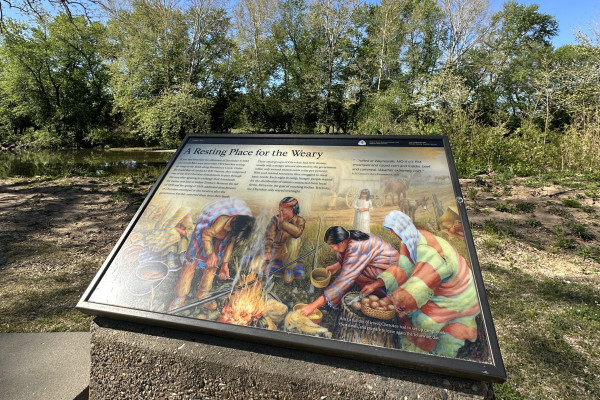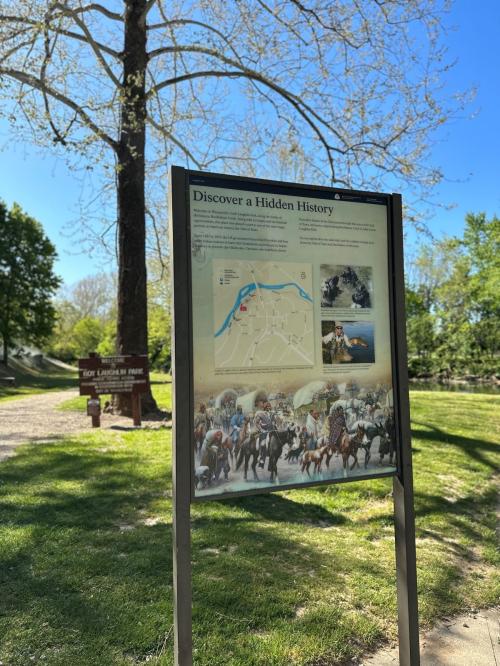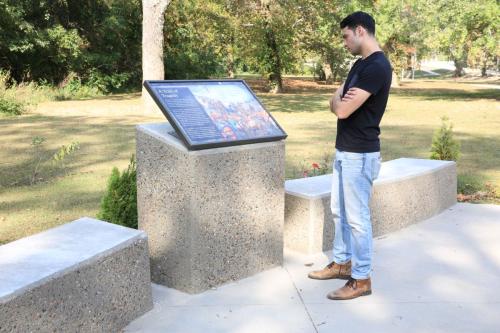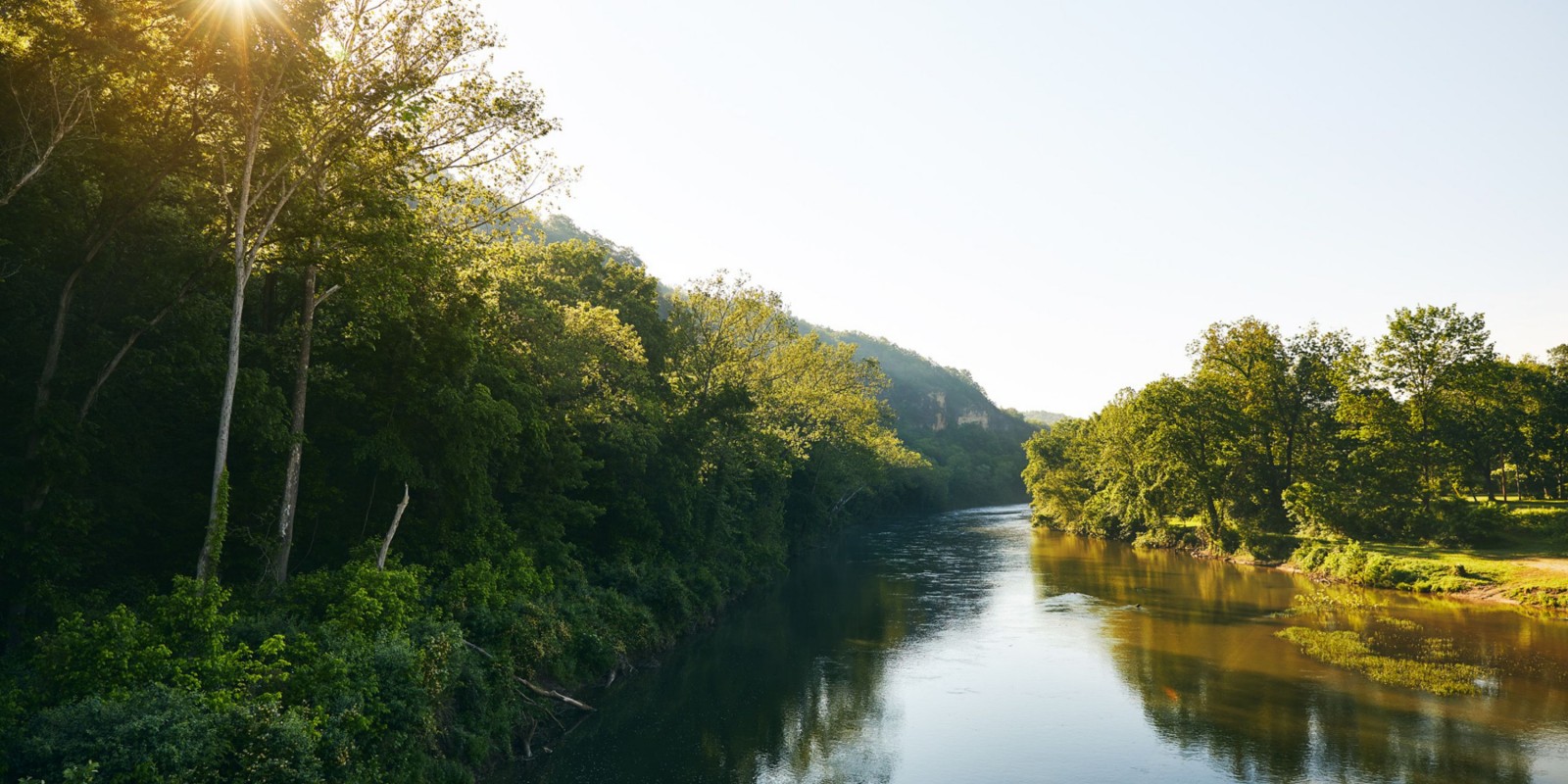Stories
Tranquility & Tragedy: Native Americans in Pulaski County

The history of Pulaski County is multi-faceted and represented in many displays obvious to passers-by. Historic Route 66, for example, still carries transcontinental travelers across the rolling Ozarks just as it did generations ago, bearing landmarks that echo a simpler time in American transportation. The proud, patriotic heritage of Fort Leonard Wood is displayed through numerous monuments and dedications to the U.S. Armed Forces, while museums like the Old Stagecoach Stop, the 1903 Courthouse Museum, and the Frisco Depot Museum showcase the pioneering and industrial history of the county through a collection of tools and artifacts.
But just west of Waynesville’s historic city square, a sign alongside the Mother Road directs motorists to Roubidoux Spring, and there, the site where Native American refugees stopped for respite on the harrowing Trail of Tears. While perhaps the most notable monument to America’s first peoples in Pulaski County, indigenous history dates back much further than the United States itself and spans the fascinating and extraordinary lives of Pulaski County before such a name existed.
Rediscovering Remnants
 While the Osage lived west of the Ozarks, Pulaski County was known as an occasional hunting ground for the tribe. The Shawnee, Delaware, and Kickapoo all migrated to Missouri between the 1700s and 1800s before moving westward due to European expansion and other contributing factors. But Native American history in Pulaski County traces its roots much further. According to archaeologist Dr. Richard Edging, the history of indigenous peoples’ “continuous occupation” in Pulaski County dates back 10,000 years. Dr. Edging writes the first evidence of Native Americans settling around what is now Fort Leonard Wood has been dated to around 8500-8000 BC with the discovery of artifacts such as spear heads, arrow points and tool kits that were made by people of the Dalton culture (i.e., descendants of Paleoindians characterized by similarities in technology, settlement, and means of gathering food). In fact, a 2005 excavation near Roubidoux Creek unearthed a complete Dalton knife and charcoal in a rock shelter with a radiocarbon date of 8500 BC.
While the Osage lived west of the Ozarks, Pulaski County was known as an occasional hunting ground for the tribe. The Shawnee, Delaware, and Kickapoo all migrated to Missouri between the 1700s and 1800s before moving westward due to European expansion and other contributing factors. But Native American history in Pulaski County traces its roots much further. According to archaeologist Dr. Richard Edging, the history of indigenous peoples’ “continuous occupation” in Pulaski County dates back 10,000 years. Dr. Edging writes the first evidence of Native Americans settling around what is now Fort Leonard Wood has been dated to around 8500-8000 BC with the discovery of artifacts such as spear heads, arrow points and tool kits that were made by people of the Dalton culture (i.e., descendants of Paleoindians characterized by similarities in technology, settlement, and means of gathering food). In fact, a 2005 excavation near Roubidoux Creek unearthed a complete Dalton knife and charcoal in a rock shelter with a radiocarbon date of 8500 BC.
Evidence of Native American settlement has been found in numerous places around Pulaski County, Dr. Edging writes, including at Miller Cave, a once popular tourist destination that has since been closed due to vandalism. “In the early 1920s, a St. Louis archaeologist, Gerard Fowke, excavated a large portion of the cave and took away several ‘wagonloads’ of artifacts that are now housed at the Smithsonian Institution. The artifacts illustrated in Fowke’s report include spear and arrow points and pottery ranging in age from the Early Archaic to Late Woodland [periods] (6500 BC-AD 1400).” Nearby Sadie’s Cave has also yielded numerous artifacts including spear points and food remains.
At Little Freeman Cave — located along the Big Piney River near Fort Leonard Wood — Dr. Edging and his team unearthed charcoal samples dating to 7200 BC, along with various animal bones serving as evidence of the types of game favored by Native American hunters. At Joy Dave — also located near Fort Leonard Wood — archaeologists discovered “a complete Kirk corner-notched spear point” dated to about 7000 BC. And about a mile south of Devils Elbow at Merrell Cave, the remains of a young adult were discovered buried in a shallow basin pit during a 1961 excavation. Rock art has also been found at several sites around Pulaski County, including Miller Cave, Sadie’s Cave, and the Lohraff Complex along Roubidoux Creek.
“Our archaeological record shows that for several thousands of years our Native American cultures were part of a vast hunting and gathering paradise,” Dr. Edging writes. “… The themes of adaptation, longevity, uniqueness, and resilience resonate across time and link our ancient Native Americans with their historic American counterparts.”
Forced Migration
While the early history of indigenous peoples in Pulaski County paints a fascinating picture of early North American life, the region’s most famous Native American landmark was born of tragedy. Beginning in the 1830s, the United States government forcibly removed an estimated 15,500 Cherokee — in addition to 1,500 Black enslaved people — from Georgia, North Carolina, Tennessee, and Alabama to be moved to Indian Territory (modern-day Oklahoma). Now known as the Trail of Tears, this mass migration followed three routes, all of which originated around Chattanooga, TN.
The Northern Route, which began in Calhoun, TN, traveled northwest across Tennessee into Kentucky, continuing north through Southern Illinois and into Missouri by way of Cape Girardeau. The journey was arduous; the Trail of Tears Association writes, “Road conditions, illness, and the distress of winter, particularly in southern Illinois while detachments waited to cross the ice-choked Mississippi, made death a daily occurrence. Mortality rates for the entire removal and its aftermath were substantial, totaling approximately 3,000-4,000.”

On Dec. 9, 1837, the first band of Cherokee refugees came to a sparsely populated community known as Waynesville, where the weary travelers set up camp along Roubidoux Creek. Additional detachments arrived between 1838-1839. The pure, spring-fed creek provided clean water for both drinking and washing clothes, as well as plenty of firewood nearby to keep warm. Carrying very little money allocated by government funds — about 16 cents per day per person — each member of the encampment depended on sustenance contracted by local farmers. Only staying overnight, the Cherokee were forced to cross the Roubidoux the next day — a difficult task given the frigid temperatures compounded by exhaustion, illness, and malnutrition. From there, the grueling journey continued, leading the Cherokee into Northwestern Arkansas and finally into Eastern Oklahoma.
Just as the history of Pulaski County is told through stories of heroism and heartbreak, so too is the history of the indigenous cultures that once occupied the Ozarks — however briefly they were here. The lives of prehistoric and Native American cultures who either made a home here or passed through by choice or compulsion — whose stories are filled with peacefulness and pride or woe and regret — are the very essence of Pulaski County, shaping our present and future to this day.


